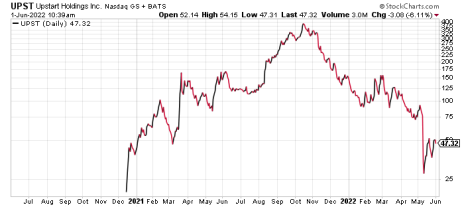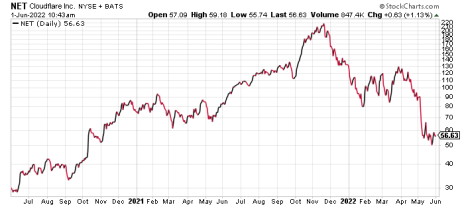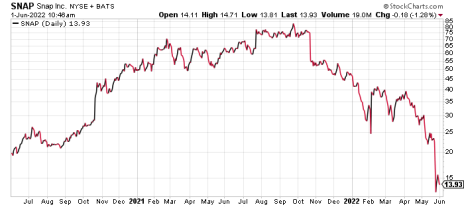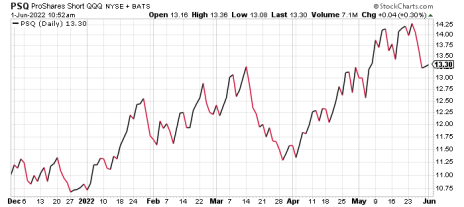Last month, I wrote about the importance of using inverse ETFs to combat this bear market in growth stocks. Today, I offer up two more inverse ETF suggestions. But first, let’s talk about the market – and your approach to investing in it.
What worked in the markets a year ago, or five or 10, isn’t working today.
Sure, there’s plenty of advice to “stay the course.” While there’s wisdom behind the idea of sticking to an investment philosophy, you don’t want to keep investing and trading like it’s the roaring bull market of 2020 or 2021.
[text_ad]
But rather than making a few tweaks here and there, investors should re-evaluate their entire approach to the markets. There are some valid reasons for this.
For example, today’s algorithm-based investment techniques have potential dangers associated with them.
That’s because they are based on what happened in the past, and the expectation that previous events will repeat themselves in the present and future.
Doesn’t that remind you of the old warning that “past performance is no indication of future returns?”
Let’s take the 2020 performance of the S&P 500 as an easy example. If you were fortunate enough to either leave your money in the market following the Covid-induced panic in February and March, you would have seen a return of 18.37% if you’d simply owned the SPDR S&P 500 ETF (SPY). That would have followed a return of 31.22% in 2019 and preceded a return of 28.75% in 2021.
But what went wrong?
3 Growth Stock Cautionary Tales
Actually, things began to go awry well before the calendar flipped over to 2022. For instance, Upstart Holdings (UPST), a cloud-based lender, went public in December 2020 and went on a rocket ride for nearly a year. But that’s changed. So far this year, the stock is down 67.2%.
Internet security and performance specialist Cloudflare (NET) has a similar story. The company made its public debut in September 2019 and rose 1,373% before beginning its decline in November 2021. In 2022, it’s dropped 55%.
While growth stocks closed 2019 and entered 2020 showing strength, pandemic restrictions, including office closures, gave many tech innovators a huge boost. The conditions allowed many of those companies to pull forward earnings by as much as three years, according to many analysts.
However, when the “work from home” trade fell apart, those stocks weakened. In some cases, it’s not just a top earner being punished for broad-market conditions, but a stock losing value because of a disappointing report or outlook.
Snap Inc. (SNAP) plunged 43% after the company warned that it would miss guidance issued only a month ago. That rattled the market, as it indicated that economic conditions may be deteriorating more rapidly than expected.
If you hold one of those stocks that nosedives, you may be kicking yourself for not (somehow) knowing you “should have” sold sooner.
We’ve all made mistakes when it comes to letting paper profits evaporate as a stock’s price sinks. It’s a frustrating situation, and reflects the emotional side of investing – or perhaps the “set and forget” side.
While it’s true that individual stocks can offer eye-popping returns in bull markets, the corollary to that is the excess risk, as the price of a single security tends to swing in a more volatile manner than the price of a basket of stocks in a diversified portfolio.
2 Inverse ETFs to Buy
ETFs offer an easy way to hedge against poor market conditions, or even to replicate the process of shorting a lagging asset class. A decade ago, we didn’t have that advantage, as very few inverse ETFs had yet launched.
For example, the ProShares UltraPro Short QQQ (SQQQ), which seeks to deliver three times the inverse of the daily performance of the Nasdaq 100 Index, has returned 66% year to date.
Meanwhile, the Invesco QQQ Trust (QQQ), which directly tracks the Nasdaq 100, is down 23.5% so far this year.
I’ll continue to urge caution about the use of those “ultra” or leveraged ETFs. That’s because a sudden shift in market direction can wreak havoc on your return. The same is true if you hold an inverse ETF for too long, either because you forgot about it, or you’re hoping to make back your initial investment after a decline.
However, it’s worth checking out more plain-vanilla inverse ETFs, such as the ProShares Short QQQ ETF (PSQ), which simply tracks the inverse of the Nasdaq 100, without using leverage to juice up the potential return.
This ETF is up 23.9% year to date.
The bottom line is: A diversified portfolio constructed with the right ETFs can not only smooth your risk and mitigate losses in a bear market, but it can also help you capture gains when more traditional portfolios are in decline.
Do you own any inverse ETFs not mentioned above that are performing well this year? Tell us about them in the comments below!
[author_ad]







